 Wash your hands regularly and wear a face mask.
Learn more
Wash your hands regularly and wear a face mask.
Learn more

Early Detection - Introduction
Testicular cancer is a rare type of cancer that has a high success rate when treated than other form of cancer. Finding cancer early when it is small and before spreading often allows for more treatment options. Some early cancers do have signs and symptoms which leads to seeking medical attention. Sometimes lump of the testicle is usually the first symptom, where the testicle might be swollen than its normal size, yet some testicular cancer can bring up symptoms at its latter stage.
This is why most medical doctors advises men to make testicles self-examination as part of their physical routine check-up (monthly after puberty).
Testicular Cancer Self-Examination
According to Medical Scientist, self-examination is the best way to detect any form of changes in the human body, and seek medical attention once they are noticed; and the best time for men to examine their testicles is during or after a bath or shower, when the skin of the scrotum is relaxed or warm.
Though, it is normal for a testicle to be slightly larger than the other, or one testicle hanging lower than the other, yet one should always report any form of changes noticed to a medical doctor.
Diagnosis
Testicular cancer can be diagnosed using different types of tests. Tests are used to determine if the cancer might have spread to another part of the body which might be different from its initially position. When testicular cancer spreads to another part of the body, it is referred to as metastasis cancer; that is why tests such as imaging tests help shows how the cancer might have spread. And this helps medical doctors ascertain the best type of treatment to work.
Medical doctor uses test to diagnose testicular cancer due to different factors, and these factors include:
Physical Examination
This is usually the first diagnosing method used by medical doctors. In this form of examination, the testicles are felt for any form of swelling, tenderness, or hardening. The abdomen, neck, armpits, upper chest for any form of enlarged lymph nodes in case the cancer has spread. Nipples or breasts is also checked for any abnormal growth.
Ultrasound
This is another way in which medical doctors diagnose testicular cancer early. Here, sound waves are sent to the body to show images of the inside of the body. The ultrasound helps to show any changes which can include benign condition (such as hydrocele or varicocele) or solid tumor. When the lump is shown to solid, it is more likely to be a cancer.
Blood Tests
There are some blood tests that can help diagnose testicular tumors or cancer. Many testicular cancers (example are the pure seminoma) can produce high levels of certain protein in the body which are referred to as tumor markers such as alpha-fetoprotein (AFP) and human chorionic gonadotropin (HCG). So, blood tests can help detect these abnormalities in the blood and help proffer a better treatment plan.
Biopsy
A biopsy is the removal of a small amount of tissue for examination under a microscope. In the place of testicular cancer, medical doctor takes a small amount of sample from the testicle for further investigation under a microscope. The result from the biopsy would help determine if there is a presence of testicular cancer or not.
Imaging Test
This is the use of x-rays, sound waves, radioactive substances to create images of the internal part of the human body. Ultrasound of the testicles is also a type of imaging test, yet other form of imaging tests can be done for different reasons after testicular cancer diagnosis; and these reasons includes:
Other Tests
X-Rays: The x-rays create pictures of different part of the internal part of the body especially the chest, using a small amount of radiation. When x-rays are done on the chest, it is used to determine the stage of the cancer; to know if the cancer has spread to the chest, and also for follow-up screening.
Computed Tomography (CT) Scan: Just like x-rays, the CT scan sends various pictures of the body but from different angles. It is usually used to know the stage or extent of the cancer by showing if testicular cancer might have spread to the lymph nodes, lungs, liver or other organs.
Magnetic Resonance Imaging (MRI) Scan: An MRI scan uses magnetic field to create images of the inside of the body, and it can determine the size of the tumor. Generally, MRI scan is used to examine the brain and the spinal cord of the body, but when medical doctors have reasons to believe that testicular cancer might have spread to the brain or the spinal cord; they also make use of MRI scan.
Positron Emission Tomography (PET) Scan: Generally, PET scan is not used for the diagnosing of testicular cancer except when combined with CT scans. A PET scan help spot cancer cells in the body. It is used to see if testicular cancer might have spread to the lymph nodes that are still enlarged after chemotherapy.
Bone Scan: A bone scan is used to show if there is any presence of cancer in the bones, especially if there is a reason to think testicular cancer has spread to the bone due to symptoms such as bone pain, or probably if other form of test result shows no clarity.
[Next Article: Staging Testicular Cancer]
References: American Cancer Society; WHO; WebMD, Cancer.net
© Medical Tutors Limited